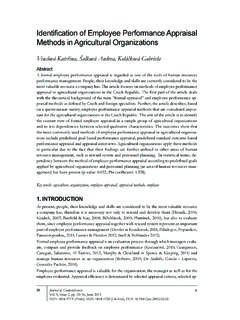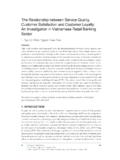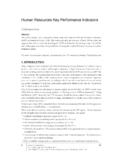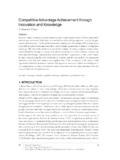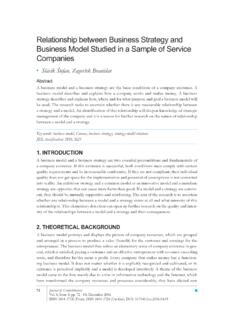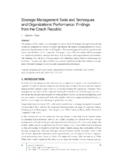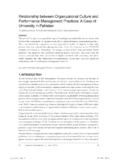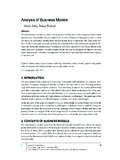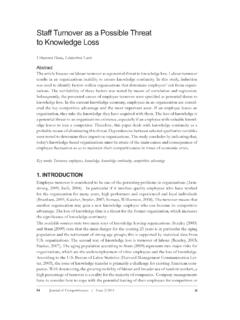Transcription of Governance Structure of Strategic Alliances - Evidences ...
1 Journal of Competitiveness 1 Vol. 4, Issue 2, pp. 172-184, June 2012 ISSN 1804-171X (Print), ISSN 1804-1728 (On-line), DOI: of Competitiveness Governance Structure of Strategic Alliances - Evidences From the South Moravian RegionEst lyiov Krist naAbstractThe objective of the paper is to explore the Governance Structure of Strategic Alliances created by small and medium enterprises in the South Moravian Region. It deeper examines contrac-tual Alliances between Strategic partners with focus on the contract and also deals with the protection of intellectual property rights in the investigated firms. To gain data for investiga-tion, both primary and secondary research have been applied.
2 Within the former the main data collection methods were the questionnaire survey and semi-structured personal interviews. The overall goal of the paper is to enhance the knowledge about the creation and functioning of Strategic Alliances in the Czech paper is organized in the following way: first of all, the notion of Strategic alliance is in-troduced. Next, the main forms of Governance Structure are presented in more details. This is followed by the objective and the methods of research. The results present the main findings of the research and discuss them in broader context. The conclusions recall the main findings and reveal the space for further investigation. Key words: Strategic alliance , Governance Structure , equity alliance , non-equity alliance , joint venture, minority alliance , contractual alliance , intellectual property rights, SMEs1.
3 INTRODUCTIONF irms have increasingly seen Strategic Alliances as attractive forms of cooperation through which they can grow and expand (Gulati & Singh, 1998). While there are plenty of studies dealing with Strategic Alliances , they may differ in definition of alliance . Commonly, alliance is any cooperative agreement voluntary initiated between firms that can involve exchange, sharing or co-development, and it can include contributions by partners of capital, technology, or firm-specific assets (Gulati & Singh, 1998, p. 781). Haas (1997) furthermore emphasises the pool of risk between partners and the integration of functions in order to reach the joint goals. Buz dy and Tari (2005) note that cooperation in an alliance is principally long-term, lasting obviously more than one year.
4 In order to remain competitive, firms must react to the signals from their environment contin-uously. To do so, a flexible access to several tangible and intangible resources is needed, which is often difficult, especially in case of small and medium enterprises (SMEs). Ring and Van de Ven (1992, p. 483) notify that Alliances represent an efficient way to keep pace, especially in case firms are seeking unique and pioneering resources . Thanks to globalization the creation of inter-organization connections is growing in inten-sity. Vod ek and Vod kov (2002) emphasise that recent Strategic Alliances create complex networks consisting of bilateral connections. They involve not only firms, their customers, 1 suppliers, investors and other stakeholders, but also organizations, as research centres and universities.
5 These complex networks have undoubtedly great importance, but in order to gain more specific results, the attention in the research described in this paper is focused only on inter-firm researches has also pointed out that along with the growing number of Alliances there is an increase in diversity. According to Gulati and Singh (1998) one of the determinants are the formal structures used to organize the cooperation. This topic has been a subject of numer-ous researches (Das & Teng, 1996; Casciaro, 2003; Comino et al., 2007; Kuittinen et al., 2009). Parkhe (1993) sees alliance Structure as a critical determinant of alliance performance. Research in the Czech Republic in the field of Strategic Alliances lags behind the Western Eu-ropean countries in volume and results.
6 One of the reasons is undoubtedly the lack of interest and activity of the SMEs. According to Zelen (2011) the problem lies in the culture of entre-preneurship and the way entrepreneurs look at cooperation in the Czech Republic. In many cases the effort for self-sufficiency and the protection of know-how are preferred to creation of closer cooperation with the business partner. The investigation of Alliances and other forms of cooperation based on networks is included in the publications of Pitra (2001), Lednick and Van k (2004), Skokan (2004), Mikol (2005), Nenad l (2006), Vod ek and Vod kov (2006), D dina and Odch zel (2007), Bla ek et al. (2009) and others. However, the current state of knowledge in the Czech Republic still lacks results from researches focusing on certain aspects of alliance formation, such as the early stages of formation, alliance management practices, alliance performance measurement, dis-solution of Alliances .
7 Governance Structure is also one such area. 2. alliance STRUCTUREA lliance Structure embodies a certain degree of hierarchical elements which can be character-ized by the extent of control and coordination (Gulati & Singh, 1998). Prior research influenced primarily by transaction cost theory have focused in great deal on the appropriation concerns in Alliances originating from contracting obstacles and pervasive behavioural uncertainty. The researchers have observed that the greater the appropriation concerns, the more hierarchical the Governance Structure of the future alliance tend to be enabling hierarchical controls in the form of control by fiat, monitoring and alignment of incentives. Thanks to the variety of organization structures firms face numerous possibilities in structur-ing their alliance .
8 In relation with this variety there is an incoherrence among researchers in determination of what alliance is. Some of them (Vod ek & Vod kov , 2006) consider alli-ance in its most narrow sense only cooperation without any share of equity. Others (Buz dy & Tari, 2005), include also cooperation with minority equity share between firms. The widest definition of alliance involves common equity of partners joint venture (Das & Teng, 1998; Gulati & Singh, 1998; Arino, 2003; Child, 2005; Comino et al., 2007). The author of the paper follows the latter way of understanding alliance . Journal of Competitiveness 1 Determinants of alliance structureScholars in previous researches have distinguished and studied several determinants of alli-ance Structure .
9 The most frequent of them are the followings:the volume of anticipated coordination costs at the time of alliance formation - the greater the volume of anticipated coordination costs, the more hierarchical the Governance struc-ture was (Gulati & Singh, 1998);the complexity of arrangements they are related with the anticipated coordination costs of cooperation; the higher the complexity the higher the anticipated coordination costs of the alliance (Gulati & Singh, 1998; Dent, 2003); repeated ties between the partners repeated ties diminish hierarchical controls in alli-ances (Gulati & Singh, 1998);the existence of prior dealings or a social network between the parties previous relations between the parties can reduce moral hazard problems and diminish hierarchical controls in Alliances (Gulati & Singh, 1998; Dent, 2003).
10 Careful investigation of these determinants by the parties should result in a proper alliance Governance Structure design. Classifying Governance structuresResearchers have distinguished dimensions of hierarchical control in distinct types of allianc-es, where each of them can be characterized by specific levels and forms of command Structure and authority systems, standard operating procedures, incentive systems, dispute resolution procedures, etc. (Gulati & Singh, 1998).Non-equity or contractual alliancesContractual Alliances are similar to arms-length market exchanges in sense of the independ-ency of the parties and their equal basis for business (Gulati and Singh, 1998). Partner firms work together directly from their own organization without equity share or unification under common ownership.
